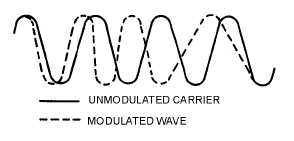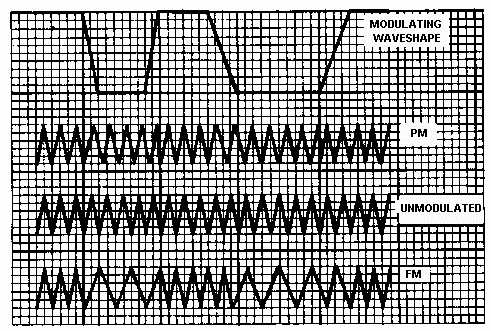2-23
Figure 2-19.—Carrier with and without modulation.
The presentation of these two waves together does not mean that we transmit a modulated wave
together with an unmodulated carrier. The two waveforms were drawn together only to show how a
modulated wave looks when compared to an unmodulated wave.
Now that you have seen the phase and frequency shifts in both fm and pm, let’s find out exactly how
they differ. First, only the phase shift is important in pm. It is proportional to the af modulating signal. To
visualize this relationship, refer to the wave shapes shown in figure 2-20. Study the composition of the fm
and pm waves carefully as they are modulated with the modulating wave shape. Notice that in fm, the
carrier frequency deviates when the modulating wave changes polarity. With each alternation of the
modulating wave, the carrier advances or retards in frequency and remains at the new frequency for the
duration of that cycle. In pm you can see that between one alternation and the next, the carrier phase must
change, and the frequency shift that occurs does so only during the transition time; the frequency then
returns to its normal rate. Note in the pm wave that the frequency shift occurs only when the modulating
wave is changing polarity. The frequency during the constant amplitude portion of each alternation is the
REST FREQUENCY.
Figure 2-20.—Pm versus fm.
The relationship, in pm, of the modulating af to the change in the phase shift is easy to see once you
understand AM and fm principles. Again, we can establish two clear-cut rules of phase modulation:





